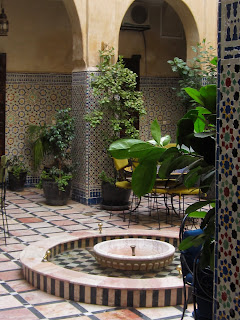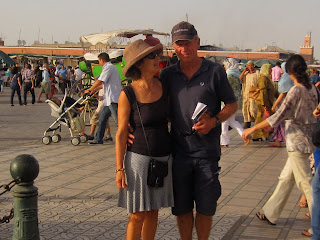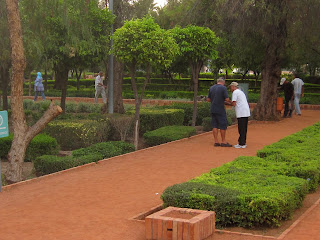Tuesday, July 20th.
Ross decides the swell is becoming larger, is uncomfortable and is putting strain on the equipment so we come into the large industrial port at Safi.

He is also very tired as he hasn´t had much sleep when the boat was doing its corkscrew motions in the eaevy swell. There is no marina here , so we are invited to tie up to a huge fishing boat near the harbour master´s office. Again the formalities take about 3 hours to complete. In comparison, once we entered the Mediterranean we did not have to go through the formalities again. We soon learn the Moroccan bureaucracy is quite exacting, even with its own residents e.g. Chakib had to hand in his passport at each port we stopped at even though he has always lived here. He found this very frustrating.
Ross is very appreciative of Chakib´s mechanical knowledge. He is a retired manager of the aviation technical and mechanical staff at Royal Morocco. He helps with a couple of problems and finding their solutions.


Chakib helping with mechanical advice
 A typical fishing boat of the area
A typical fishing boat of the areaThe skipper of the fishing boat is happy to watch Impulsive while we go ashore for a few days, at a cost, of course. We feel Impulsive is safe here so look forward to some exploring.
Disembarking from the this fishing boat is extremely difficult. It is away from the dock and with the tidal changes it is either a huge climb up or a big leap down. Which ever way it is i have to have help.
The trip to Essaouira on the local bus is quite an experience. It is very hot and there is no air-conditioning, but there are curtains to pull across to block the sun. Lively arabic music and singing are playing on the radio. The bus is full with people standing all along the isle for the 120 ks. trip. The bus stops often, and later in the trip in very isolated places. Some of the coastal views with the high cliffs and famous surf beaches in the area are spectacular. We pass through dry and arid farming areas with their farm houses, and see many working donkeys and mules. There are many dry-stone fences, and many rocks scattered through the paddocks. Later we pass through green, low wooded areas and richer looking farmlands. The trip takes about three an a half hours.
 Essaouira
EssaouiraEssaouria is an old Portugese port . It is a very popular and attractive coastal town because of its incredibly long stretch of beautiful beaches. We enjoy a walk along the promenade watching board riders and colourful parasailors.

We also visit the port and are very pleased we didn´t bring the boat here. It is known to have strong winds and the pilot book suggests entering here is difficult. There are only 3 yachts here all rafted up, in amongst a huge fishing fleet. We wonder how the inner boats get out when they want to as there is so much congestion here.

The start of the promenade along the main beach
We also visit the port and are very pleased we didn´t bring the boat here. It is known to have strong winds and the pilot book suggests entering here is difficult. There are only 3 yachts here all rafted up, in amongst a huge fishing fleet. We wonder how the inner boats get out when they want to as there is so much congestion here.
 Strong winds outside the port
Strong winds outside the portAlso Safi is in a better position for us to leave from to cross the Atlantic to the Canary Islands because it gives a more useful angle to use the predominant n.east wind here.
It is lovely to come here with Chakib as this is where he has a holiday apartment and so knows the area very well.

We also visit the medina and see many artisans working with thuja wood, a specialty of the area.There are many artists here too, all working in tiny workshops throughout the narrow, cobbled streets. Some of them are in the old fortifications.
 Artisans workshops in the old fortifications
Artisans workshops in the old fortifications
The old fortifications
We have dinner in a restaurant attached to a hotel just outside the medina walls. Ross and I can´t believe we are so cold. There is a strong sea breeze here. We are traveling as lightly as possible and never dreamt we might need a jacket.
 Keeping warm at the restaurant - it is such a surprise to be cold!
Keeping warm at the restaurant - it is such a surprise to be cold!It is wonderful to stay the night at Chakib´s apartment in a very tranquil area a few ks. out of the town. We have a very comfortable and deep sleep. Ross is particularly tired after our night at sea because he couldn´t sleep with the yacht going through its corkscrew like movements in the swell. It is such a treat for us to stay with someone in their home.
 Breakfast at Chakib´s house
Breakfast at Chakib´s house
 Breakfast at Chakib´s house
Breakfast at Chakib´s houseWe are in contact with Didier all the time and all our plans change from day to day. We decide to hire a car today to return to the boat and check all is well before heading off to Marrakesh. After a trip into town in the very small and crowded local bus with definitely no tourists on it,this proves to be a difficult task at this time of the year but finally Chakib and Ross track down an excellent car with driver. The trip takes only half the time of that in the bus yesterday. Ross particularly wants to check the headsail is tied down firmly and also that the gas is turned off.

Impulsive is in good hands with the skipper of the fishing boat so we repack and head off again, this time for Marrakesh.
The drive to Marrakesh takes two and a half hours. It is flat and dry, and later there is the mountainous backdrop with patches of greener areas. We wonder if these areas have springs.
It is extremely hot in Marrakesh today, in the mid 40´s. The driver drops us off near the main square where Ross and Chakib try to phone some Riads . They have no luck so we find another taxi to try to locate one to stay in. The taxi driver assures us that all the Riads are booked out. This is a risk we have to take traveling the way we are, but it is very disappointing as it will be our only opportunity to stay in one of the old mansions.
We are dropped off near the main square to try some of the hotels in this area. Just by chance we go into a place to exchange some money and Ross asks the young man he deals with there for accommodation suggestions. He says he has a family place nearby who will look after us, and organizes for his off-sider to escort us there. We are very pleased to find there is room at Riad Omar, just near the main square. The rooms aren´t wonderful but we are thrilled to be here. It is a lovely building and the decor is typical of the old mansions with the tiles and mosaics and central courtyard. Being up on the terrace in the cool of the evening is a welcome relief after the heat of the day.
 Riad Omar
Riad Omar The courtyard
The courtyard
Planning our route to the Atlas mountains
This afternoon we enjoy a late, light lunch and a relax at the riad before setting off in the early evening now the sun is lower in the sky and it´s not so hot. The large and famous main square is lively, buzzing and crowded, with its many orange juice stalls on large carts,and entertainment e.g. snake-charmers and Berber (indigenous inhabitants of Morocco ) dancers and women making henna. We feel for all the women wearing chadors in this heat - they must be so hot.

The main square

Carts selling orange juice
 Buildings near the main square
Buildings near the main square The gardens near the Minaret
The gardens near the Minaret The Cyber Park
The Cyber ParkWe walk around the Koutoubia Minaret, and then through the Cyber Park where it is at least 15 degrees cooler in these lovely gardens. After a long walk Chakib encourages us to take a ride back to the main square in a horse drawn carriage, which is very pleasant. We agree with his phrase that the horse is a noble animal.


The minaret seen from the horse drawn carriage
Marrakesh is expanding rapidly. The new part of the city looks very modern and there are many up-market shops. It is known as the "rouge" city. Most of the buildings are in hues of this colour, you can see it in the paving stones and even the buses are partly this colour. There are several water fountains which add a cooling effect.
 A partly "rouge " bus
A partly "rouge " busThe medina is covered so is cooler although with the crowds passing through it seems quite "close" at times with not much fresh air coming through. There are many souks and artisans with all their wares. (Fez is still our favourite medina)
 The covered Medina
The covered MedinaToday we hire a car. Chakib is happy to drive which is wonderful, especially as he knows his way around all these areas so well. We visit the Pavilion de la Menara and its gardens. It is an old retreat of the king´s with a large lake built in the C12 for the soldiers to learn to swim in before departing to Andalusia.

Pavilion de la Menara
There are roses everywhere in full bloom in the Marrakesh area.
Then we continue on towards the Atlas mountains which is only an hour and a half drive. We are looking forward to the cooler and fresher air in this area. It is a spectacular drive to the town where we are staying in the foothills of the mountains. Chakib is obviously well known at this small hotel. He really enjoys being in the mountains and now he is retired he can spend more time here. We enjoy lunch at one of the typical riverside restaurants. The tables and chairs are scattered under the trees (large willows and silver birches) in the shade or by the river. It is a very peaceful setting across a bridge.


Restaurant across the river
 A table set up in the river
A table set up in the riverThe walk up to the waterfalls, the Setti Fatma cascades, is picturesque and challenging, especially for Ross who climbs up to next section with Chakib.

Ross and Chakib climbing up to the next section
It is wonderful to see so many people enjoying this lovely place and it is free.
 The waterfalls
The waterfalls
Water cooling system for the drinks
 Looking back to the village where we are staying
Looking back to the village where we are stayingMost people who visit here just come for the day so once all the cars leave it is very tranquil as is the following morning. The sailing has been quite difficult and tiring so we are enjoying a few quiet days.
 Woman working in the field opposite our hotel
Woman working in the field opposite our hotel
A restaurant across the bridge
 Pouring tea at breakfast, Arabic style
Pouring tea at breakfast, Arabic style Hotel where we stayed
Hotel where we stayedThis morning we take a road with a very steep and winding ascent to the nearby National Park. The foothills where we stayed last night are very fertile and there are many citrus trees growing, The export of these fruits e.g. oranges and melons , and tourism are the main source of economy in Morocco.
The mountains then become arid and their massive sheer cliffs look spectacular. Then we reach the belt of cedar trees. These are high up and must look a wonderful sight when they are covered in snow. Up near the summit is Oukamden which is a ski resort. There is no one here now but apparently it is very busy in winter with all he hotels fully booked.
 Oukamden
Oukamden Looking across to the highest summit in Morocco with small amounts of snow
Looking across to the highest summit in Morocco with small amounts of snowFrom a high vantage point we can see the highest summit in Morocco and it is still covered with small amounts of snow. Chakib points out some of the tracks he has walked along across in the distance They look very difficut. prt from slipping on the sloping and steep tracks there is the concern of falling boulders and at night they use a sealed tent to keep out snakes and scorpions!
Throughout this region in the mountains are the berber villages and many signs of hard work. Young boys are herding sheep nd goats, sometimes helped by the women. Chakib says the women work very hard physically in the mountains. We have seen many of them carrying heavy loads on their heads and children on their backs.
As with the ascent , descending there are very red cliff faces and many sites where slate is produced in this reddish hue.
 Steep descent
Steep descent
Goats being herded, often by small boys
We finally meet up with Didier later this afternoon in Marrakesh. It is wonderful to see him again. His daughter , Olivia has just being staying with our Heather and her family for a week in Australia. Olivia is 10, the same age as Lachie. Anna and Lucinda have enjoyed having her very much. Olivia is improving her english with this exposure to the language.
Didier has come with Rasheed who has his family and his mother with him. He drives us back to Impulsive at Safi, in convoy with his family and their driver.
It takes a long time to get Didier in through customs and the harbour master ,even though he has a business based in Agidir. He has a french passport. Finally they allow him in to stay for dinner on the boat but he is not allowed to stay the night on Impulsive as planned. It is so disappointing he gets sea sick because he has a lot of sailing experience , including crossing the Atlantic, and obviously enjoys being on the boat.
 Didier on board Impulsive, with Rasheed and his son
Didier on board Impulsive, with Rasheed and his son
Didier remembering his knots
We prepare a barb-e que for dinner (Rasdeed´s family have gone to a hotel, except for his oldest son who is 8). I am very embarrassed when we present our wonderful steaks to learn Rasheed and his son can´t eat them because they are not prepared correctly for muslims. I share my fish with them but am sorry I didn´t know before. We find other dishes on board but it would have been lovely to present them with a meal they could really enjoy.
 Difficulties disembarking
Difficulties disembarkingIt takes Ross three hours to clear customs etc. and we leave Sali at 11.30am for the Canary Islands, after many farewells with Didier, Chakib and Rasheed, and his family.
These wonderfully friendly and hospitable people have given us the best possible insight into their rich culture here.
 Leaving Safi
Leaving SafiThe islamic faith is strong here but is moderate and tolerant. It interests us that it is said that the Koran states that men and women are to be treated equally. It is the different imans who have changed this.
We are also fascinated with the rubbish problem in Morocco. The people must be clean to pray but they generally think nothing of just throwing their rubbish down anywhere. Perhaps with the increase planned for tourism this may change. Ross saw a sign around the Sali port to control rubbish so maybe it is starting to be controlled.
Ross and I have only had 1 or 2 glasses of alcohol during our stay in Morocco. It has actually been very good for us and we didn´t really miss it at all. We do wonder though if perhaps the Moroccans may be better to drink wine than all the coca-cola they consume?
Favourite recipes this leg:
Fatma´s Moroccan Couscous (they enjoy this meal every friday night)
This north African dish is made with steamed or soaked semolina, and served with spicy meat and vegetables.
Balbenou´s Moroccan cookies
These are served with mint tea which is served in the silver teapot and served by lifting the pot high up and down to mix the tea and sugar through the tea.
We also enjoy the Moroccan Tajenes.
This is a north African stew of spiced meat and vegetables prepared in a shallow earthenware dish with a tall, conical lid.








